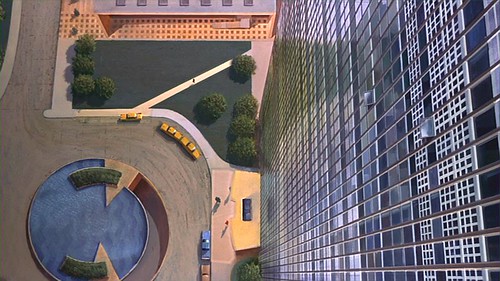This post is part of the CMBA Trains Plane and Automobiles Blogathon, running from October 19th - 24th. Click below for a list of the other weary travelers on the filmic highways and byways!
 Anyone who has known me very long knows that while I love the work of Alfred Hitchcock, the film that rises to the top of the heap is his action masterpiece, North by Northwest. It hits all the notes a Hitchcock film should
– no surprise considering co-writer Ernest Lehmann has said it was his plan to
write "the Hitchcock picture to end all Hitchcock pictures".
Anyone who has known me very long knows that while I love the work of Alfred Hitchcock, the film that rises to the top of the heap is his action masterpiece, North by Northwest. It hits all the notes a Hitchcock film should
– no surprise considering co-writer Ernest Lehmann has said it was his plan to
write "the Hitchcock picture to end all Hitchcock pictures".He started with Hitch to pen an adaptation of The Wreck of the Mary Deare – they couldn’t get a hook on the film, but they got along famously. Ernest offered to drop from the project, but Hitch would hear none of it – they whipped up a mad plot and pitched it the producers, who suddenly couldn’t care the Mary Deare wrecked or not.
The primary kernel of the plot was based on a true story –
Journalist Otis C. Guernsey once told Hitch about a fictitious secret agent
manufactured by a couple of British secretaries, which the German agents
started wasting time following around.
Otis began to work up a story about a traveling salesman mistaken for
the agent, but even though he couldn’t make head or tail of the plot, Hitch
bought the idea from him for ten grand.
He and Lehmann took the idea and started folding in all the set pieces
Hitch had been wanting to do, including a chase across Mount Rushmore.
Lehmann used to work on Madison Avenue, and came up with the
idea of making the traveling salesman (which they first thought would be great
for Hitch-alumnus James Stewart) into a stylish ad-man, for whom they rightly
cast Cary Grant. We’ve often joked that Cary Grant could easily have played the
role that James Mason played, that of mastermind and Mover of Government
Secrets (Perhaps) Philip Vandamm, but Mason could never have played Roger
Thornhill. He’d have been able to look
at the Glen Cove constabulary and asked, "Do you honestly believe that
this happened the way you think it did?", they would immediately reply,
"Er, no, sir, you must be right, you're free to go, sorry we bothered
you." Now, a film with James Stewart as Thornhill and Cary Grant as
Vandamm? Where’s my parallel dimension
transporter?
 |
| I hope they're not still at the bar waiting for Roger... |
The film sneaks into paranoia film territory here – when he
attempts to relate his story to the police, all evidence of the events are
erased from the mansion, and the people living there claim he’d been there for
a party and left in an advanced state of inebriation. He makes his way back to the Plaza and finds
the enigmatic Mr. Kaplan’s room, his mother (Jessie Royce Landis) in tow, and
nefarious characters on their tail.
It’s at this point the scene shifts and Hitch uses one of
his classic tricks – giving the audience information the characters in the film
don’t have, so we understand more about what’s going on than they, and making
the whole situation more suspenseful. We
learn that Mr. Kaplan does not exist – we learn it seven times, to be precise –
in a wonderful bit of expository dialogue, a board room of spymasters, led by
“The Professor” (Leo G. Carroll, made up to look like one of the Dulles
brothers) they explain in exacting detail that Kaplan is a fiction, a decoy,
created to give the Bad Men someone to chase, while their real operatives can
work undiscovered. They learn of Mr.
Thornhill’s predicament, and choose to do nothing, gleeful at the prospect that
their decoy has suddenly sprouted legs and is quacking all on his own.
 |
 |
| Hitch did love the Fist-I-Cam shot, didn't he? | |
From there we watch Roger “hunt for a man that doesn’t
exist”, as the trailer describes it, from Chicago to a cornfield to an art
auction to Mount Rushmore to a hospital to Abraham Lincoln’s nose. And if that breakneck list makes you want to
see the film, you had the same response as the MGM producers when he shot it
past them.
 |
| You could run a film class on any one of the shots from Hitch's movies. |
And as for that last shot of the train going into a tunnel? Hitch gleefully confirmed it means exactly what we all thought it did.


